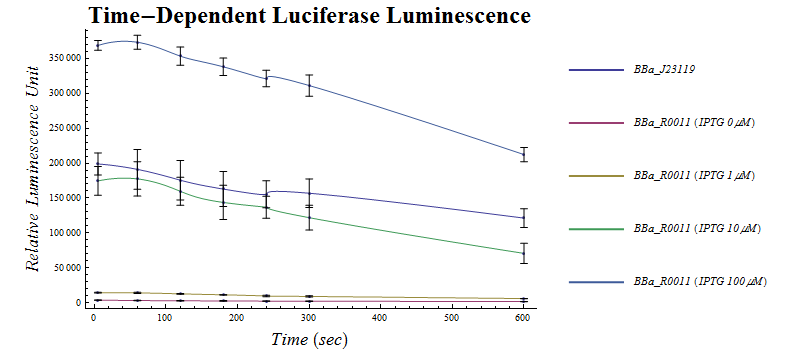Part:BBa_K518002
Firefly-renilla dual luciferase assay kit
Luciferase assay is one of the most popular reporter assay system for quantitatively measuring the function of promoters and other cis-elements. The wide-ranging and quantitative detection is the prominent feature of this assay; light emmision from 10~(-18) ― 10~(-11) mol protein can be quantitatively measured using luminometer (see our results). A promoter or other cis-element to be analysed can be ligated above this part. Its effect will be measured as an altered firefly luciferase expression. Meanwhile, renilla luciferase expression can be used to as an internal control.
Calibration
We performed a calibration for Photynus pyralis (Firefly) luciferase using standard reagents of enzyme and D-luciferin. Reagents were granted from Berthold Japan (Tokyo, Japan). Luminescence was measured using a luminometer GENE LIGHT 200 from MICROTEC, Co., Ltd. (Chiba, Japan).
The result indicates that under 1000 luciferase molecules can be detected, and that luciferase amounts can be well estimated by a simple linear regression in a logarithmically seven-digit range (from 10^(-20) to 10^(-13) mol). Again, we can easily get the numerical information of how many molecules exist, not just the arbitrary luminescence units.
Since we can estimate the number of cells in a test tube from various data including OD600 value, we are able to estimate how many luciferases are translated in a single bacterium on average.
<Fig 1. Estimation of firefly luciferase amount by linear regression.>
Usage
We performed a test of this cassette using BBa_J23119 and BBa_R0011. We successfully verified the IPTG-dependence of BBa_R0011, and at the same time, the potency of this part as an evaluation tool. For experimental and analytical details, see [http://2011.igem.org/Team:UT-Tokyo our page].
<Fig.1: Time-dependent luminescence measurement of firefly luciferase. The first graph shows the raw data obtained by triplicate experiments. Data is presented as mean ± S.D.. The second graph is a model fitting according to the enzymatic kinetics theory.>
<Fig.2: Time-dependent luminescence measurement of renilla luciferase.>
<Fig.3: Demonstration of promoter evaluation. Relative Promoter Unit (RPU) is calculated as: (maximum of firefly luminescence) / (maximum of renilla luminescence). Data is obtained from triplicate experiments. Data is expressed as mean±S.D..>
Sequence and Features
- 10COMPATIBLE WITH RFC[10]
- 12INCOMPATIBLE WITH RFC[12]Illegal NheI site found at 1790
Illegal NheI site found at 1813 - 21COMPATIBLE WITH RFC[21]
- 23COMPATIBLE WITH RFC[23]
- 25COMPATIBLE WITH RFC[25]
- 1000INCOMPATIBLE WITH RFC[1000]Illegal BsaI.rc site found at 2392
Illegal SapI.rc site found at 827
Contribution by 2022 iGEM Team Jiangsu_United
The Luciferase reporter system is a reporter system which uses luciferin as substrate to detect the activity of firefly luciferase. Luciferase can catalyze the oxidation of luciferin to oxyluciferin. During the oxidation process, luciferin will emit bioluminescence. The bioluminescence released during oxidation of luciferin can then be measured by a fluorescence detector, also known as a luminometer or a liquid flash detector. The bioluminescence system, luciferin and luciferase, can detect gene expression very sensitively and efficiently. It is a method to detect the interaction between transcription factors and DNA in the promoter region of target gene.
Transcription factor is a kind of protein molecule with special structure and function of regulating gene expression, also known as trans-acting factor. Some transcription factors bind only to specific sequences in their target promoters. These specific sequences are called cis-acting elements. The DNA binding domain of transcription factors and cis-acting elements achieve covalent binding, thus inhibiting or enhancing gene expression. Luciferase reporter assay (luciferase assay) is an important method to detect the specific sequence binding between these transcription factors and their target promoters
Engineering
To confirm the activity of hFoxO1 protein to activate downstream gene expression, we chose two kinds of luciferase for detection. What’s more, we also chose AS1842856, which is a small component that can inhibit the activity of hFoxO1, as control group.
As shown in Fig.1, after the addition of different concentrations of positive control (AS1842856), we could see a gradient of luciferin activity and concentration dependence, proving that positive control has an inhibitory effect on hFoxO1 transcriptional activation. This means the hFoxO1 transcription activation platform constructed by us is successful and can be used for follow-up experiments.
//function/reporter/light
| None |







